Chapter 17.34
DESIGN REVIEW
Sections:
17.34.020 Scope of design review.
Legislative history: Ord. 97-406.
17.34.010 Purpose.
The design review board and the director of community development review and make urban design decisions to promote visual quality throughout the city. This chapter establishes design criteria and a procedure for reviewing the design of development projects in the city. The purposes of the design review procedure and criteria include, but are not limited to, the following:
A. To provide design objectives to be used by the design review board and the director in evaluating proposed development applications.
B. To implement the city’s comprehensive plan policies by promoting high-quality urban design and development.
C. To encourage and promote the public health, safety and general welfare of the citizens of the city, including the development and coordination of municipal growth and services.
D. To encourage originality, flexibility, innovation in site planning and development, including the architecture, landscaping and graphic design of proposed developments in relation to the city as a whole and/or surrounding areas.
E. To aid in ensuring that structures, signs and other improvements are properly related to their sites and the surrounding sites and structures, with due regard to the aesthetic qualities of the natural terrain and landscaping and that proper attention is given to exterior appearances of structures, signs and other improvements.
F. To protect and enhance the city’s pleasant environments for living, working, and shopping activities.
G. To support and stimulate business and industry and promote the desirability of investment and occupancy in business and other properties.
H. To ensure compatibility between new and existing developments.
I. To maintain and protect property values and the tax base supporting city services.
J. To provide a unique visual identity for the city and its neighborhoods.
K. To ensure that landscape areas and streetscape areas are adequately and attractively landscaped.
L. To reduce the potential for erosion and stormwater runoff.
M. To preserve water quality, natural hydrologic patterns, and ecological vitality through LID best management practices.
N. To provide a mechanism for preserving existing significant vegetation where possible and practical. (Ord. 2010-718 § 19 (Exh. S); Ord. 2009-702 § 2 (Exh. C); Ord. 2006-642 § 2; Ord. 2005-609 § 2)
17.34.020 Scope of design review.
A. The design review board (DRB) shall review the following for consistency with this chapter:
1. All building elevations and landscape plans for attached single-family residential, multifamily residential, industrial, and commercial developments.
2. All streetscape landscaping and monument signs for detached and attached single-family residential, multi-family residential, industrial, and commercial developments.
3. All design of landscaping for city rights-of-way, medians, entrances, and other public facilities and city-owned properties.
4. Any other elements of site design if required as a condition of development approval by the hearing examiner or director.
B. The site design criteria specified in MCMC 17.34.040 shall be incorporated in the review of preliminary plats, planned area developments, and binding site plans for detached and attached single-family residential, multi-family residential, industrial and commercial developments.
C. The director shall review building/wall sign applications pursuant to MCMC 17.26.010 for consistency with MCMC 17.34.040. The director may also review minor modifications pursuant to MCMC 14.09.010 to items previously approved by the DRB and/or city. (Ord. 2014-777 § 3; Ord. 2010-718 § 19 (Exh. S); Ord. 2010-717 § 2 (Exh. B); Ord. 2009-702 § 2 (Exh. C); Ord. 2006-642 § 2; Ord. 2005-609 § 2)
17.34.030 Approval required.
A. No design review approval shall be granted, no building permit shall be issued, and no construction shall begin until the design review board and the director have completed the review specified in MCMC 17.34.020 and determined that the requested action is consistent with the design criteria set forth in MCMC 17.34.040.
B. Design Review Board Application – Submittal Requirements.
1. Buildings and Site Development Plans. The following information and materials shall be submitted to the city for review under this chapter:
a. A completed application.
b. Site plan at a scale from one inch equals 20 feet to one inch equals 50 feet, showing:
i. Location of all proposed structures and any existing structures to be retained or incorporated into the development.
ii. Location of building setback lines.
iii. Proposed pedestrian and vehicular circulation including driveways, access points, sidewalks and pedestrian pathways.
iv. Parking lot layout, design and loading areas if applicable.
v. Public improvements including sidewalks, curbs, gutters, etc.
vi. Location of existing trees and vegetation to be retained.
c. Building material samples and color chips.
d. Plans and section drawings depicting the relationship of the proposed project to abutting properties and buildings.
e. Building elevations and/or perspective renderings drawn to scale and indicating the exterior color and material composition (including mechanical equipment and screening).
f. Roof plan including the location of mechanical equipment.
g. A lighting plan, if required, adequate to determine the location, character, height and style of fixtures and the amount and impacts of spillover on adjacent properties.
h. A brief narrative description of the design elements or objectives of the proposal and discussion of the project’s relationship to surrounding properties.
i. DRB application fees as established in MCMC 3.42.170.
2. Landscape Plans. The following information and materials shall be submitted to the city for review under this chapter:
a. A completed application.
b. Site plan at a scale from one inch equals 20 feet to one inch equals 50 feet, showing:
i. Location of all proposed structures and any existing structures to be retained or incorporated into the development.
ii. Proposed pedestrian and vehicular circulation including driveways, access points, sidewalks and pedestrian pathways.
iii. Parking lot layout, design and loading areas if applicable.
iv. Public improvements including sidewalks, curbs, gutters, etc.
v. Location and size of existing trees and vegetation to be retained.
vi. Plans and section drawings depicting the relationship of the proposed project to abutting properties and buildings.
vii. Landscape plan showing the location of proposed plant materials, including a plant schedule identifying plants by common and scientific names, spacing, size at time of planting, size at maturity, location of any existing vegetation and trees to be retained, identification of native species, and special notes.
viii. Photographs of proposed plant material.
ix. Plans showing proposed grading/topography, drawn to the same scale as the landscape plan.
c. DRB application fees as established in MCMC 3.42.170.
3. Sign Plans. The following information and materials shall be submitted to the city for review under this chapter:
a. A completed application.
b. A site plan, drawn to scale, showing the location of the building upon which the sign will be installed, surrounding buildings, and adjacent streets.
c. A drawing showing the size, shape and exact location of the proposed sign(s). For wall- or building-mounted signs, the drawing shall portray the proposed sign’s relationship to any existing or proposed signs located on the same facade or common building wall. Drawings must be to scale or contain dimensions indicating the size of the sign and the length and height of the appropriate building surface.
d. Dimensions, area (in square feet), and style of letters/symbols of the proposed signs.
e. A colored illustration of the proposed signs.
f. Sign materials (wood, plastic, metal, etc.) and color samples.
g. For signs requiring DRB approval, application fees as established in MCMC 3.42.170.
4. The director may require the submission of such other information determined to be appropriate and necessary for a proper review of the requested action. (Ord. 2010-718 § 19 (Exh. S); Ord. 2009-702 § 2 (Exh. C); Ord. 2006-642 § 2; Ord. 2005-609 § 2)
17.34.040 Design criteria.
The following design elements shall be utilized by the applicant when preparing development proposals and shall be utilized by the DRB and the director when reviewing a development application requiring review per MCMC 17.34.020. When specific design guidelines have been adopted for an area or site as part of a specific development approval, those guidelines shall be utilized in conjunction with design elements listed below. For example, development in the planned community business zone district shall also be subject to the town center design guidelines as adopted in city council Ordinance No. 97-404, as amended.
A. Site Design. The following design elements shall be applied to all projects:
1. Site Design Layout.
a. Sites shall be developed in a coordinated manner to complement the natural topography and drainage, and adjacent structures through building placement, architecture and size/mass.
b. Whenever possible, buildings on the same site shall be designed to enhance safe and convenient pedestrian access between buildings including plazas, courtyards, pocket parks, and other pedestrian use areas connected by clearly marked walkways.
c. Where appropriate, sites shall incorporate transit-compatible designs. “Transit compatibility” means designs that are pedestrian oriented, provide safe and convenient access to transit facilities, and foster efficient transit service.
d. Where appropriate, sites shall be designed to provide vehicular and pedestrian connections to adjacent sites.
e. Private open space shall be incorporated into attached single-family and multi-family residential projects in accordance with MCMC 17.22.060.
f. The use of LID best management practices is required whenever site and soil conditions make it feasible, including pedestrian facilities such as trails and sidewalks. LID best management practices include, but are not limited to, minimizing impervious surfaces, designing on-site LID stormwater management facilities, and retaining native vegetation.
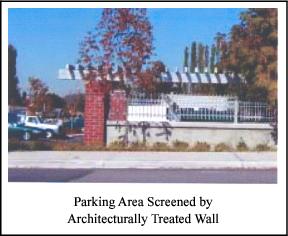
2. Parking Lot Design and Screening.
a. Project design shall avoid the appearance of domination by automobiles. Positive methods to achieve this concept include:
i. Orienting buildings to fronting streets and placing parking at the rear and/or sides;
ii. Designing the required parking area into smaller, discrete, connected lots rather than large, single-use lots;
iii. Designing parking areas to be partially screened from view from adjacent streets and building occupants. Screening can be accomplished through a number of methods including:
(A) Orienting buildings away from parking areas;
(B) Placing buildings between streets and parking lots;
(C) Using extensive landscape screening, berms, and architecturally treated walls that also allow visibility to provide adequate safety and surveillance of the parking areas.
iv. The use of LID best management practices in parking lots is required whenever site and soil conditions make it feasible. Such BMPs include, but are not limited to, permeable surfacing materials and integrating LID stormwater management facilities into the required landscaping.
3. Tree Preservation.
a. Project design shall maximize the preservation of existing significant tree stands and significant individual trees, especially on slopes, street frontages, and on the perimeter of the site.
b. Project design shall incorporate existing natural vegetation into the site design wherever possible.
c. Trees that are to be preserved shall be subject to the standards established in MCMC 15.10.045 and penalties established in MCMC 15.10.075.
4. Storm Drainage.
a. Open stormwater facilities (i.e., ponds and bioswales) visible from public areas shall be designed as site amenities and shall provide a natural appearance through layout, design, and landscape treatment. If fencing is determined to be necessary by the city, it shall be installed in accordance with MCMC 17.22.040 and public works policies, and be obscured with landscaping.
b. Stormwater facilities (whether open facilities or vaults) shall be located outside roadway buffers/cutting preserves unless there is no other feasible alternative and the facilities do not compromise the purpose and function of the roadway buffer/cutting preserve. In such cases, the facility may only be located in the outer portion of the roadway buffer/cutting preserve.
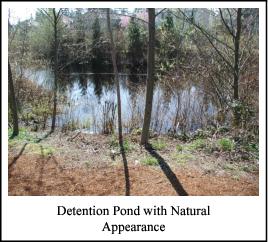 c. Where located under areas to be landscaped, underground stormwater vaults shall have adequate soil cover to support the approved landscape plan. The soil shall be of sufficient quality to properly support vegetation.
c. Where located under areas to be landscaped, underground stormwater vaults shall have adequate soil cover to support the approved landscape plan. The soil shall be of sufficient quality to properly support vegetation.
d. Stormwater bioretention facilities that are integrated into interior landscape areas within parking lots, and that meet area and landscaping requirements may be counted toward the interior parking lot landscape requirements.
5. Vehicular Entrances.
a. Vehicular entrances shall be designed to welcome residents, customers, and visitors. Gated entrances on public right-of-way are prohibited. Gated entrances on private roads are strongly discouraged.
b. At the primary vehicle access point(s) to a site, signage identifying the address should be clearly visible from the street and the entrance shall be highlighted with elements such as:
i. Freestanding development identification sign;
ii. Ornamental entrance features;
iii. Water feature(s);
iv. Identifying architectural features such as arbors or trellises;
v. Functional, accent lighting;
vi. Artwork;
vii. Landscape treatment with seasonal color (such as annuals or flowering trees), including planter boxes or pots;
viii. Decorative or textured pavement.
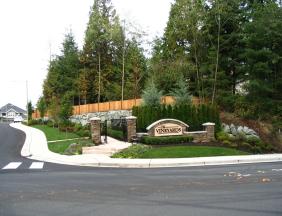 6. Sidewalks, Trails, and Pedestrian Walkways.
6. Sidewalks, Trails, and Pedestrian Walkways.
a. Within developments, a comprehensive system of pedestrian walkways shall link together all site entrances, building entries, parking facilities, and common outdoor spaces with the sidewalk system within or adjacent to the public right-of-way.
b. Along arterials and collectors (within a right-of-way or roadway buffer/cutting preserve), sidewalks and trails shall be meandering and continuous between developments, and shall also conform to ADA and building code requirements for pedestrian safety, where appropriate.
c. Pedestrian walkways shall incorporate pedestrian-scale lighting, bollard lighting, landscaping, accent lighting, and directional signage into the design of the walkways.
d. Site furnishings adjacent to sidewalks/paths such as pedestrian kiosks, benches, newspaper stands, decorative banners, trash receptacles, bus shelters, hanging flower baskets, and planting pots shall be made of durable, weather-resistant, vandal-resistant materials.
 7. Public Open Space (Commercial Development). New or renovated commercial buildings are strongly encouraged to provide adequate public open space at building entrances for public use. The space should be suitable to place sidewalk furniture and as a public gathering place.
7. Public Open Space (Commercial Development). New or renovated commercial buildings are strongly encouraged to provide adequate public open space at building entrances for public use. The space should be suitable to place sidewalk furniture and as a public gathering place.
8. Screening of Utilities and Service Areas.
a. On-site service facilities, such as loading docks, dumpsters, etc., shall be located in areas least visible from the right-of-way, public spaces and main parking areas. Service areas shall be screened from view using landscaping or screen walls.
b. Where possible, all utility areas, meters, and vaults shall be screened by a combination of masonry, wood, and/or planting areas. Where possible, building mounted utilities shall be placed within utility rooms or enclosures.
c. All screening shall reflect building architecture of the adjacent building and be compatible with adjacent project designs. This shall include consideration of proportion, color, texture, and materials. Ground level outdoor enclosures shall be composed of materials similar to the main structure.
 B. Commercial and Business Park/Industrial Building Design. Building design should provide a sense of permanence and timelessness. The following design elements shall be applied to commercial, business park/industrial buildings.
B. Commercial and Business Park/Industrial Building Design. Building design should provide a sense of permanence and timelessness. The following design elements shall be applied to commercial, business park/industrial buildings.
1. Design and Materials.
a. No single architectural style is required. However, reliance on or use of standardized “corporate” or “franchise” style for commercial and business park/industrial buildings is strongly discouraged.
b. Buildings should reflect an individual design that has considered site location, conditions, and surrounding development. Materials used shall complement and express individual building design.
c. A consistent visual identity shall be applied to all sides of buildings visible to the general public. In these areas, all building sides shall have an equivalent level of quality of materials, detailing, and window placement. Abrupt ending of architectural details shall be avoided with no radical change in details, features, or materials.
d. Primary building entrances shall be pedestrian in scale and shall be clearly identifiable and visible from the street and nearby pedestrian routes and shall be marked by four or more of the following architectural elements:
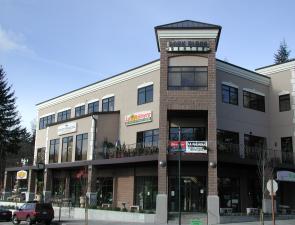 i. Recess;
i. Recess;
ii. Overhang;
iii. Canopy;
iv. Portico;
v. Porch;
vi. Sidelights flanking door;
vii. Ornamental lighting fixtures;
viii. Large, textured entry door(s);
ix. Special paving, stone, masonry or patterned tile paving in entry;
x. Ornamental building name or address;
xi. Pots or planter boxes;
xii. Fixed seating;
xiii. Artwork;
xiv. Water feature;
xv. Ornamental gate or fence;
xvi. Open space plaza or courtyard.
e. Canopies or awnings shall be provided along pedestrian streets and storefronts. The minimum depth of any canopy or awning shall be six feet unless limited by the building code. The vertical dimension between the underside of a canopy or awning and the sidewalk shall be at least eight feet.
f. Illumination within or below the awning shall be allowed only if the awning material is opaque.
g. Building design shall incorporate traditional building materials such as masonry, stone, stucco, heavy timbers, brick, and other natural appearing materials.
h. Building colors should accent, blend with, or complement surroundings. Bright or brilliant colors should be reserved for trim and accents.
i. Materials used for site features such as fences, screen walls, and signs should complement building design through materials, color, shape, and size.
j. Modulation (defined as a measured setback or offset in a building face) shall be incorporated to reduce overall bulk and mass of buildings. The planes of exterior walls should not run in one continuous direction more than 50 feet without an offset or setback.
k. Blank walls on buildings and parking structures are to be avoided. Positive methods to achieve this objective include changes in colors and materials, placement of windows, use of awnings and canopies, and architectural details and features such as corners, setbacks and offsets. Examples of details include:
i. Masonry;
ii. Concrete or masonry plinth at wall base;
iii. Belt courses of a different texture and color;
iv. Projecting cornice;
v. Projecting metal canopy;
vi. Decorative tile accents;
vii. Trellis with plant material;
viii. Medallions;
ix. Opaque or translucent glass windows;
x. Artwork;
xi. Vertical articulation, such as pilasters or columns;
xii. Decorative light fixtures;
xiii. Recesses;
xiv. Windows;
xv. Secondary entrances;
xvi. Balconies;
xvii. Awnings.
2. Transition Elements.
a. Developments shall provide transition with adjacent buildings. No single building or development shall dominate adjacent uses in terms of location, size, bulk, view blockage, or shading. New developments shall incorporate elements that can extend and reinforce desirable qualities. Examples include:
i. Roof forms;
ii. Massing;
iii. Window patterns;
iv. Setbacks;
v. Cornice lines/belt courses;
vi. Complementary vegetation;
vii. Entry features (e.g., porches, canopies);
viii. Siding/roofing materials;
ix. Colors.
b. One or more of the following methods shall be used to reduce the potential contrast between developments that vary in density and intensity:
i. Transition building heights for buildings adjacent to residential property;
ii. Siting garages next to the property line adjacent to lower density residential properties;
iii. Increasing the amount of vegetation along the property line adjacent to residential development;
iv. Retaining more existing trees along the perimeter adjacent to residential development;
v. Erecting a decorative wall or fence along the adjacent property line.
3. Ground Level Details/Transparency.
a. Storefronts, windows, merchandise, and other aspects of business activity shall be visible by people traveling along public streets.
b. Commercial and business park/industrial buildings shall have a distinct “base” at the ground level, using articulation and materials that suggest stability and strength, such as stone, masonry, or decorative concrete. Distinction may be provided by utilizing the following elements:
i. Windows;
ii. Architectural details;
iii. Bays;
iv. Belt courses and cornice lines;
v. Lighting or hanging baskets supported by ornamental brackets;
vi. Plinths for columns;
vii. Continuous sills along base of storefront windows;
viii. Projecting window sill ledges;
ix. Masonry accents, e.g., tile;
x. Planter boxes or pots.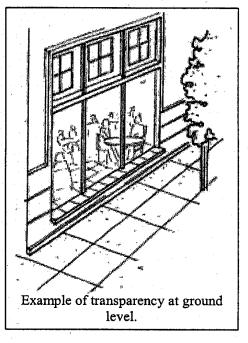
c. Windows at ground level may be tinted; however, reflective, filmed (except for transparent films used for energy conservation) and mirrored windows are prohibited. A minimum of 50 percent of any ground floor commercial building facing a primary street or parking lot shall be clear-vision glass. A minimum 25 percent of any ground floor building facing any other street shall be clear-vision glass.
d. The “middle” of the building shall be made distinct by change in material or color, windows, balconies, and setbacks.
e. The “top” of the building shall emphasize a distinct profile or outline, with elements such as a projecting parapet, cornice, or upper level step-back, or pitched or flat roofline.
4. Roof Expression and Form.
a. Commercial and business park/industrial buildings shall include extended parapets and projecting cornices to create a prominent edge. Roof forms may be sloping or flat depending on the overall design character of the building and surrounding buildings.
b. Mixed commercial/residential buildings may have sloping or flat roofs depending on the overall design of the building and surrounding buildings.
c. Dormers or intersecting rooflines should be used to break up continuous sloped roofs.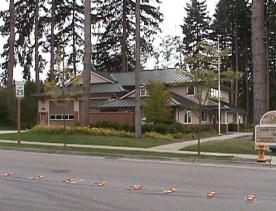
d. Flat, unembellished parapets shall not be permitted. Decorative cornices shall be used along the top of parapet walls.
C. Residential Building Design. Building designs should provide a sense of permanence and timelessness. The following design elements shall be applied to attached single-family and multi-family residential buildings:
1. Design and Materials.
a. Residential buildings within the project should reflect a unified design theme that has considered location, placement of buildings, site conditions, and surrounding development. A uniform appearance shall be avoided.
b. Individual residential buildings should avoid a uniform appearance by providing variation in building architecture and elevations using methods such as building modulation and changes in exterior materials, colors, windows, trim, doors, and roof forms.
c. A consistent visual identity shall be applied to all sides of buildings visible to the general public. In these areas, all building sides shall have an equivalent level of quality of materials, detailing, and window placement. Abrupt ending of architectural features and details shall be avoided.
d. Building design and construction methods shall incorporate traditional materials such as wood, brick, masonry, and other natural materials.
e. Building colors should accent, blend with, or complement surroundings. Bright or brilliant colors shall be reserved for trim and accents.
f. Site features such as fences, screen walls, and signs should complement building design as well as the character of surrounding development through the materials, color, shape, and size of the feature.
g. Modulations (defined as a measured setback or offset in a building face) shall be incorporated to reduce overall bulk and mass of multi-family buildings and to strengthen their residential character. The planes of exterior walls should not run in one continuous direction for more than 50 feet without an offset or setback.
h. Blank walls on residential buildings shall be avoided. Design methods to achieve this element include changes in colors and materials, placement of windows, and architectural details such as dormers, window trim, brackets, trellises, decorative railings, balconies, and porches.
2. Roof Expression and Form.
a. Attached single-family buildings shall have pitched roofs. Multi-family buildings may have pitched, sloping or flat roofs depending on the overall design of the building and surrounding development.
b. Dormers or intersecting rooflines should be used to break up continuous sloped roofs.

c. Where flat roofs are used, decorative cornices shall be used along the top of parapet walls. Unembellished parapets shall not be permitted.
D. Compact Residential Development Design. For the purposes of this chapter, compact residential development means attached or detached residential development that, in the director’s determination: (1) results in a cohesive neighborhood design with smaller lot sizes and/or reduced setbacks, and (2) facilitates the efficient use of land by reducing impervious surfaces, utility extensions and roadways, while protecting environmentally critical areas, providing pedestrian friendly streets, and providing usable open space. In addition to the building design elements for residential buildings, the following design elements shall be applied to compact residential developments:
1. Dwellings should be designed to have covered landings at the front door, and porches that are at least deep enough to allow pots with plantings (six-foot minimum depth). Porches deep enough to allow for seating are encouraged.
2. Garage doors that front on the street shall be de-emphasized by at least one of the following methods:
a. Porch roof over garage doors;
b. Living space cantilevered over garage doors;
c. Side garage entry;
d. Trellis or architectural feature;
e. Two eight-foot-wide garage doors;
f. Garage doors setback of five feet beyond the principal facade;
g. Rear loaded alleys (access).
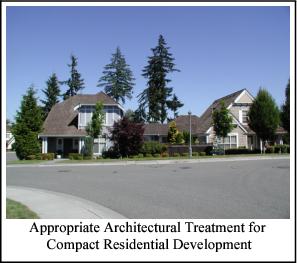
E. Screening Equipment Design. Outdoor mechanical equipment, including ground level and rooftop mechanical and communication equipment, shall be screened from view. The method of screening shall be architecturally integrated with the building with respect to materials, color, shape, and size.
 F. Building and Wall Sign Design.
F. Building and Wall Sign Design.
1. Sign size shall be consistent with the regulations contained in Chapter 17.26 MCMC.
2. Individual letters rather than cabinet signs are preferred.
3. Backlit individual letters are a preferred alternative.
4. Sign colors should be coordinated with building colors.
5. Signs should be compatible in scale and proportion with building design and other signs.
6. A specific sign program or concept should be designed for multiple-tenant buildings or complexes and identify the location and sizes for future signs. Color and letter style shall be coordinated when businesses share the same building and consistent sign patterns (placement on buildings) shall be utilized.
7. Exposed neon tubes are acceptable for nonletter sign elements but are discouraged for letters.
G. Freestanding Sign Design.
1. Sign size shall be consistent with the bulk and location regulations contained in Chapter 17.26 MCMC.
2. Freestanding signs should provide only the name and address of the building, building complex and/or building tenants.
3. Sign colors should be complementary to, and coordinated with, building colors.
4. Signs should be in scale and proportion with building design and other signs.
5. Freestanding signs that are internally illuminated shall be designed in accordance with the criteria set forth in MCMC 17.26.020(E).
6. Project landscaping should be designed to incorporate freestanding signs.
H. Landscaping Design. The following landscaping design elements shall be applied to all projects:
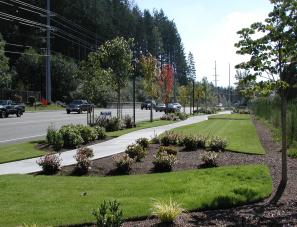
1. General Provisions.
a. Project landscaping shall provide unity of design through repetition of plants and coordination with adjacent developments.
b. Landscape materials should be hardy species that are adaptable to local conditions, easily maintained, and drought tolerant. Use of native plants and the retention of existing vegetation are strongly encouraged.
c. Streetscape landscaping, perimeter and interior landscaping, parking lot vegetation, street trees and other required landscaping shall meet the following minimum standards:
i. Deciduous trees shall be a minimum of one and one-half to three-inch caliper at the time of planting and spaced 20 to 30 feet on center or as determined by the director/DRB according to species type, which shall be well-suited to urban conditions and shall create a canopy along the street.
ii. Evergreen trees shall be a minimum height of eight feet at the time of planting and spaced as determined appropriate by the director/DRB according to species type and landscape application. A range of heights (allowing some less than eight feet) is permissible and encouraged when trees are proposed in a grouping.
iii. Shrubs and groundcover shall be a minimum size of one gallon at the time of planting.
iv. Landscaped areas shall be densely landscaped with a combination of trees, shrubs, and groundcover that will provide 90 percent coverage within three years of planting.
d. Landscaped areas shall be irrigated by mechanical sprinkler systems.
e. Landscape islands or medians shall have no dimension narrower than five feet.
f. Landscape areas or planting beds having a minimum width of five feet should be provided around building perimeters to separate buildings from surrounding pavement areas.
g. Architectural features such as low walls, fountains, and sculptures may be used in places where planting areas are limited or restricted.
h. Project entrances should be enhanced through changes in paving materials such as brick pavers, textured and colored concrete, providing entry structures and unity in planting of trees and shrubs.
i. Individual trees along walkways and along sidewalks in the internal portions of projects should be planted in tree wells or landscape beds.
j. Open stormwater detention facilities shall be landscaped and be designed as amenities in accordance with the standards set forth in subsection (A)(4) of this section.
k. Street trees within the public right-of-way shall be located in tree pits with grates or in a continuous planting strip. Street trees shall be a species listed on the latest edition of the city of Mill Creek “Approved Street Tree List,” which shall be maintained by and is available from the department of community development. If a tree species, which is not listed on the city’s Approved Street Tree List, is desired, a request may be submitted to the Mill Creek design review board for approval; however, the tree species must at a minimum be: urban tolerant, not likely to cause infrastructure damage, and able to be pruned to a height that would avoid conflicts with pedestrians and vehicle traffic.
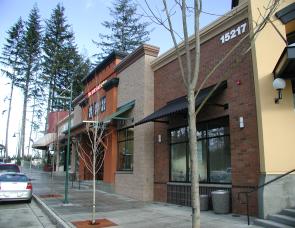
l. If a street has a uniform planting of street trees or a distinctive species within the right-of-way, then new street trees should match the planting pattern and complement the existing species type.
m. Where tree grates are required/proposed, they shall be ADA accessible and of a similar size and material as tree grates found in adjacent developments.
n. Interior site landscaping shall be designed to define pedestrian ways and building entries, enclose outdoor gathering and seating areas, screen mechanical equipment, and reduce building mass.
o. Landscaping within a roadway buffer/cutting preserve shall be consistent with the policies within the streetscape element of the comprehensive plan. Landscaping adjacent to residential areas should provide screening and privacy from roadways and utilize treatments that are natural in appearance. Landscaping adjacent to commercial areas should utilize a formal treatment and may include view corridors into the development.
2. Perimeter Landscaping and Parking Lots.
a. Required perimeter setback areas and parking lot landscape islands shall be densely landscaped with a combination of trees, shrubs, and groundcover to provide 90 percent coverage within three years of planting.
b. Pavers or stepping stones are encouraged in parking lot landscape islands to protect plant materials from damage by pedestrians. Permeable surfaces are required in parking lots whenever site and soil conditions make it feasible.
c. Where parking lot design results in head-in parking adjacent to landscape areas, the landscape areas shall be protected by wheel stops or another method adequate to prevent damage by overhanging vehicles.

d. One tree for every four parking spaces (1:4) shall be provided in surface parking lots. These trees may be distributed within and around the perimeter of the parking lot.
e. The design for parking lots shall include deciduous and evergreen trees to provide shade and break up expanses of asphalt. There shall be no more than 10 spaces between landscape islands or medians.
f. Landscape areas next to a pedestrian walkway shall be planted to provide a clear view zone between three and eight feet from ground level within a minimum of three feet abutting the edge of the walkway.
g. Project landscaping shall address the following elements:
i. Perimeter landscaping shall be designed to reduce building mass and provide visual separation between different land uses.
ii. Where applicable perimeter landscaping shall comply with the streetscape element of the comprehensive plan.
I. Lighting Design. The following lighting design elements shall be applied to all projects:
1. Lighting fixtures, standards and intensities shall be designed to be compatible with the character of the development and city standards.
2. Lighting shall be energy-efficient, glare-free and shielded from the sky and adjacent properties and structures to reduce off-site spillover.
3. Lighting design should comply with the Illuminating Engineering Society of North America’s Recommended Practices and Design Guidelines, latest edition.
4. Parking lot, common area, and pedestrian walkway lighting shall be distributed to create adequate visibility, visual interest, and security at night.
5. Moving and flashing lights are prohibited. (Ord. 2017-814 § 2; Ord. 2015-803 §§ 7, 8 (Exh. A); Ord. 2014-778 § 1; Ord. 2013-763 § 3; Ord. 2010-718 § 19 (Exh. S); Ord. 2009-702 § 2 (Exh. C); Ord. 2006-642 § 2; Ord. 2005-609 § 2; Ord. 2003-565 § 2)


